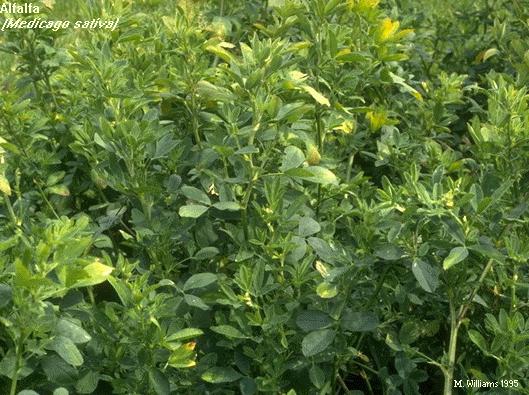Alfalfa
(Medicago sativa L.)

Introduction
Alfalfa (Medicago sativa L.), also called lucerne, originated near
Iran, but related forms and species are found as wild plants scattered
over central Asia and into Siberia. Its value as feed for horses
and other animals was described as early as 490 B.C. by Roman writers.
Alfalfa was first introduced into the eastern US by the colonists
in 1736.
Called
the "Queen of Forages", alfalfa is not only the oldest
cultivated forage crop in the US, but it is one of the most palatable
and nutritious. Alfalfa is rich in protein, vitamins, and minerals.
And, when cut prior to bloom, it is low in fiber and high in energy.
Thus, it is prized as a primary component in dairy cattle rations
and is an important feed for horses, beef cattle, sheep, and milking
goats.
Alfalfa has a very high yield potential compared with that of other
forage crops. It also is an integral component of many crop rotations
because of its ability to fix nitrogen, improve soil structure and
tilth, and control weeds in subsequent crops.
Description
Alfalfa is a herbaceous (definition link) perennial legume. A mature
alfalfa plant may have from 5 to 25 stems, which usually reach a
height of 15-25 inches (38-63 cm). Stems are branched and slender
and bear pinnately trifoliolate leaves (picture link). Leaves with
more than three leaflets are not uncommon (picture link). Leaves
are arranged alternately on the stem (picture link). Stipules are
slender and adnate (fused) to the petiole (picture link). Leaflets
are linear, oblong, or obovate oblong and are toothed toward their
apices.
Area of Adaptation
Alfalfa is worldwide in its distribution (world crop and statistical
table link) and is grown in many areas of the US, accounting for
nearly 30 million acres (12 million ha) of production. A wide range
of soil and climatic conditions are suitable for alfalfa, but for
best production it requires a well-drained soil with nearly neutral
pH and good fertility. Alfalfa should not be expected to do well
in poorly drained or acid soil or in areas where adequate water
is not available.
Primary Use
Alfalfa is used primarily as a hay crop. It has the highest feeding
value (section link) of all commonly grown hay crops when harvested
at late bud or early flower stage of maturity (table link). Alfalfa
produces the greatest amount of protein per acre of any livestock
feed. It is often used in combination with corn silage in livestock
rations to take advantage of the protein and energy content of the
two feeds. Alfalfa also can be made into silage, pellets, meal,
or cubes. With careful management, alfalfa can be used successfully
as a pasture crop.
Grazing
Alfalfa
Early season grazing of alfalfa provides a method of using the first
cutting, which often is damaged by spring rains if made into hay.
When pastures are grazed, however, the soil must be dry enough to
avoid crown damage from trampling.
If alfalfa
is used for year-round pasture, a rotational grazing system must
be provided to allow root reserves to be replenished. A rotation
that provides 30 to 35 days of regrowth is adequate. If continuously
grazed, plants should be kept between 3 and 6 inches (8-10 cm) tall
during the spring and summer and allowed to increase to a height
of 8 to 12 inches (20-30 cm) during the fall. This top growth may
be removed following a killing frost without reducing winter survival.
Bloat
(fact sheet link) often is a problem for animals on pastured alfalfa.
Unfortunately, the methods of controlling bloat often have been
troublesome, expensive, and only partially effective. Using a grass-legume
mixture in pastures, supplementing legumes with grass hays, intensive
strip grazing (section link) with electric fences (section link),
and drylot feeding have all been somewhat successful.
The most
promising preventative treatment involves the use of bloat-preventative
materials (table link). These anti-foaming compounds may be added
to drinking water, applied as a top-dressing on grain supplements,
included in pellets, or added to salt-molasses blocks supplied on
pasture. However, the effectiveness of these methods is variable
and depends upon animals obtaining a regular supply of bloat preventative.
|

